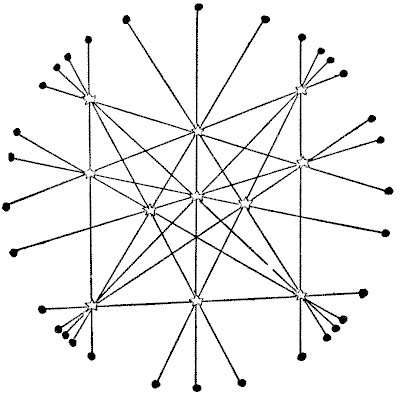(related to Problem: Turks And Russians)
The main point is to discover the smallest possible number of Russians that there could have been. As the enemy opened fire from all directions, it is clearly necessary to find what is the smallest number of heads that could form sixteen lines with three heads in every line. Note that I say sixteen, and not thirty-two, because every line taken by a bullet may be also taken by another bullet fired in exactly the opposite direction. Now, as few as eleven points, or heads, may be arranged to form the required sixteen lines of three, but the discovery of this arrangement is a hard nut. The diagram at the foot of this page will show exactly how the thing is to be done.

If, therefore, eleven Russians were in the positions shown by the stars, and the thirty-two Turks in the positions indicated by the black dots, it will be seen, by the lines shown, that each Turk may fire exactly over the heads of three Russians. But as each bullet kills a man, it is essential that every Turk shall shoot one of his comrades and be shot by him in turn; otherwise we should have to provide extra Russians to be shot, which would be destructive of the correct solution of our problem. As the firing was simultaneous, this point presents no difficulties. The answer we thus see is that there were at least eleven Russians amongst whom there was no casualty, and that all the thirty-two Turks were shot by one another. It was not stated whether the Russians fired any shots, but it will be evident that even if they did their firing could not have been effective: for if one of their bullets killed a Turk, then we have immediately to provide another man for one of the Turkish bullets to kill; and as the Turks were known to be thirty-two in number, this would necessitate our introducing another Russian soldier and, of course, destroying the solution. I repeat that the difficulty of the puzzle consists in finding how to arrange eleven points so that they shall form sixteen lines of three. I am told that the possibility of doing this was first discovered by the Rev. Mr. Wilkinson some twenty years ago.
This eBook is for the use of anyone anywhere in the United States and most other parts of the world at no cost and with almost no restrictions whatsoever. You may copy it, give it away or re-use it under the terms of the Project Gutenberg License included with this edition or online at http://www.gutenberg.org. If you are not located in the United States, you'll have to check the laws of the country where you are located before using this ebook.